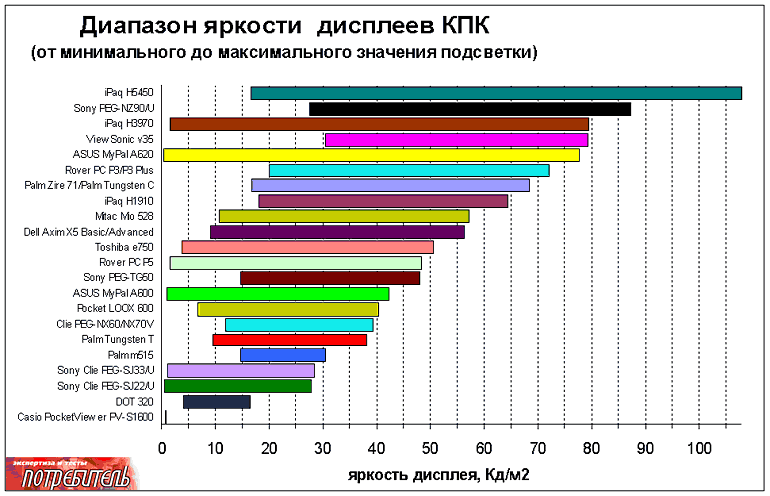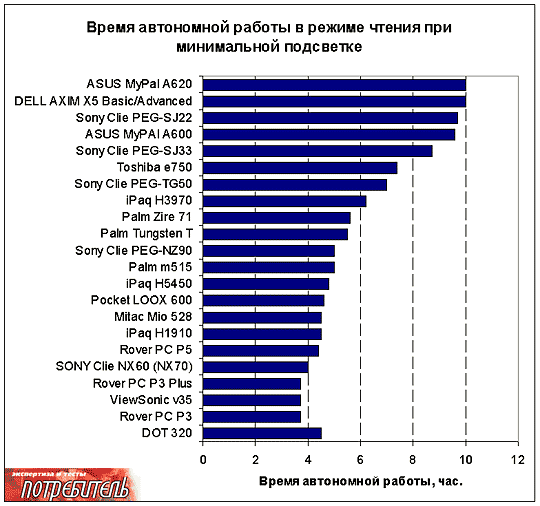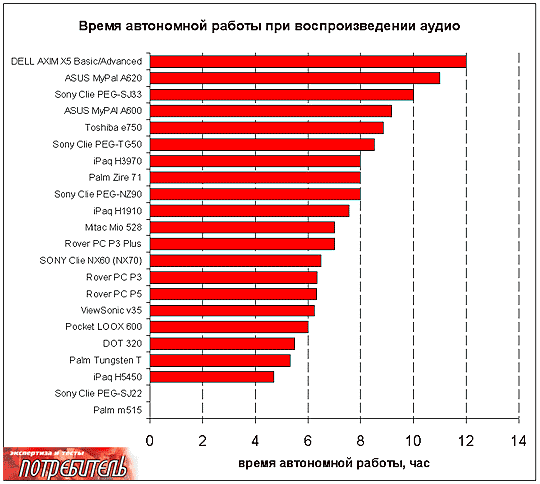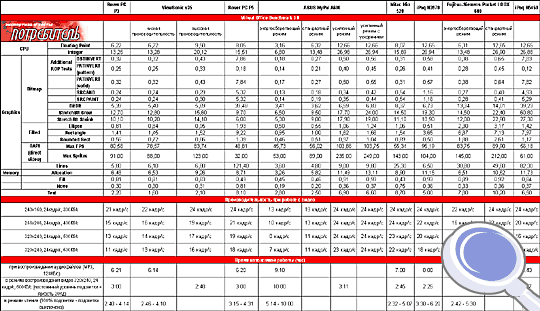Market for handheld computers gradually matures and acquires the features inherent in the increasingly market for personal computers or laptops. Talking about it and more and more increasing number of models of PDAs, and reducing the cost of computers themselves, and, of course, the emergence in this market segment growing number of manufacturers. No wonder that with such an incredible variety of computers (and in our review of them will be 24), the user is practically impossible to select the PDA itself, but the information coming from the computer itself is so scarce that an accurate opinion about any handheld computer is difficult. Take for example a typical configuration of PDAs running PocketPC 2002: Intel XScale processor 400 MHz, 64 MB RAM and 32 MB ROM, 3.5''screen. What is it? We now find it difficult to reply so soon, what is the computer: it can be Toshiba e740 or ASUS MyPal A600, but maybe this Pocket LOOX 600. It seems to be the same set of parameters, and how much can be different computers. There is a fair question, but maybe they're all the same, and the need to buy any, which will attract more design or who just turns out to be cheaper? To answer this question unequivocally, first, we reviewed all publications on handheld computers in print and online in the last couple of years. And paradoxically, the answer to our question in its entirety could not be obtained. The information was completely fragmented and the overall picture did not develop. For example, a characteristic of such a statement: "This handheld runs 4:00 in the second division of illumination, but this one - 6 hours on the same second division." Which PDA is better? Probably the one that works longer, but if placed next to these computers, it would appear that the same division of the display of the first CCP will be two times brighter than the second. And, indeed, as you can compare the PDA with each other?
What should I test?
To select the comparison, first and foremost, we must understand why you do need a PDA.
Display
Most of the time (approximately 90-95% of the time working with PDA) happy owners of handheld computers use them as a device for obtaining visual information or data entry. It's - reading electronic books, e-mail, edit documents, notes, notepad. Less often - to listen to music, watching videos or work in games. But in all these cases, except for listening to music, we are working with the display, viewing any information from this same screen. And most of these cases - is to work with text. Perceptual quality of the text a person determine the contrast and brightness. To determine the quantity of contrast used the following method. Simulated conditions equivalent to reading e-books under different conditions of ambient lighting. PDA display was illuminated at an angle of 40 °. The detector of optical radiation intensity meter was used, taking into account the spectral sensitivity of the human eye. The distance between the detector and the surface of the display was 30 cm then displayed a chessboard with black and white cells and measured the brightness of the white (Bmax) and black (Bmin) cells. Then the well-known formula to compute the optical contrast. All measurements were performed for four types of exterior lighting: in total darkness, in conditions equivalent to the coverage of a train underground, in conditions equivalent to office lighting, and strong solar illumination. Built four curves the values of contrast, depending on the level of backlight: backlight is switched off by up to a maximum illumination. Immediately say, that in the case of light off the contrast in the dark is always zero. The range of brightness displays all PDAs can be seen on the chart.
 |
All PDAs are divided by type of backlight into two categories: computers with a reflective backlit transflective with backlight. For the former, the maximum contrast does not exceed 82% (1:10), for the second better than 94,5% (1:36).The first category includes: DOT 320, Palm m515, Palm Tungsten T, Pocket LOOX 600, ASUS MyPal A600, Rover PC P5, Mitac Mio 528. The second category: Sony Clie PEG-SJ22 / U, Sony Clie PEG-SJ33 / U, Clie PEG-NX60/NX70V, Sony PEG-TG50, Toshiba e750, Dell Axim X5 Basic / Advanced, iPaq H1910, Palm Zire 71, Rover PC P3 / P3 Plus, ASUS MyPal A620, ViewSonic v35, iPaq H3970, Sony PEG-NZ90 / U and the iPaq H5450.
Runtime
PDA in the first place is attractive because, no matter how corny it sounds, it is pocketable. What does this mean? This means that the size of a computer small enough to fit in your pocket. Consequently, it can always be with you, did you not burdened: not in the office, on the road, often where there is no access to electricity. Consequently, the computer must, simply must have a long battery life. And that is true, what kind of computer that has a battery sit down after 1-2 hours. Second, after the display quality, the requirement for a PDA - it's battery life. To check the battery life in read e-books has been selected program iSilo. This application starts with auto-scroll text (when we read, we do not just look at the screen, while leafing through a book or on their own using hardware buttons or use the autoscroll feature - both consumes some portion of battery power). Speed auto-scroll chosen the same for all measurements 20-25 characters per second. In this way, we measured the battery life, depending on the level of illumination (backlight from completely off to maximum brightness). Since even the lowest brightness of the display is enough to read in almost any ambient lighting condition, then the graph shows a comparison of computers in autoscroll mode, the text with a minimum display brightness.
 |
Battery life when playing music defined by the time playback of MP3 files with the flow of 128Kb / s with the screen off PDA (where possible).
Battery life for video playback was determined with the same brightness displays 30Kd/m2 time play the file with the flow of 600Kb / s..
Performance
Performance requirements Pocket PC depend on the type carried out their tasks. By types of tasks PDAs can be divided into four categories: organizer, music player, video player, game station. To work on documents, notebook, calendar, diary, organizer and e-book reader does not need a special performance, are all available in the market of PDAs cope well with the function of the organizer. To play music in greater need is not high performance computer and hardware capabilities. Most modern PDAs running PocketPC 2002 have the opportunity to work at a lower frequency of the processor (power-saving mode - usually with a frequency of 200 MHz) and thus actually increase the battery life of your computer. If such a regime exists in the CCP, for reading electronic books, or organizer functions, I strongly recommend to switch to this mode. Loss of performance, you will not notice, but the increase in battery life will feel like. Performance plays an important role when it comes to video playback. To real-time video decoding with the flow in the 500-600 kb / c, you must have a high performance handheld computer.To analyze the performance of video playback for computers running Pocket PC 2002, used the program of video playback Pocket TV Enterprise Edition (specially adapted for processor PXA). In order to evaluate the performance of the CCP, the video played out four different resolutions and different values of the data stream: 240h120, 300 kb / c; 288h208, 400 kb / c; 320x240, 500 kb / c, and 320x240, 600 kb / c. By launching all these videos from the memory of PDA, compared with the numbers falling in the second frame (for all the clips were originally 24 frames per second). By the number of "dropped" frames estimated, to play some movies fit this pocket PC. Gaming applications for both PC and Pocket are of two types: not requiring high performance handheld computer (board games, card games, puzzle games), and vice versa, with more claims to computer resources (arcade games, simulators, "Shooter" ). To analyze the overall performance of the handheld computer (only in case of Pocket PC 2002) used the latest version of the synthetic test from the company's Virtual Office VO Benchmark 3.0 with built-in test plots.
Cost
At a cost of all handheld computers can be divided into three categories. The first - a category of low cost computers. The cost of the CPC is low and does not exceed $ 350. Usually it is computers running PocketPC 2002 that differ from their more expensive brethren truncated ROM, or PDA with Palm OS entry level. The second level - are computers the middle class. This is a classic Pocket PC or a PDA running Palm OS 5.0 or equipped with a built-in wireless connection standard Bluetooth or Wi-Fi, or with higher specifications. And finally, the third category - an expensive business model for those who need high performance and wireless capability. This is Sony's handheld with built-in Bluetooth, camera or PDA PocketPC with built-in 802.11b, Bluetooth and a fingerprint reader.
Test
On the basis of the above characteristics, I have tried to analyze the specifications of most commercially available handheld computers. Description of new products was carried out in more detailed form, unlike older models, PDA.




